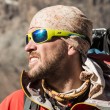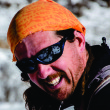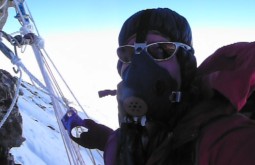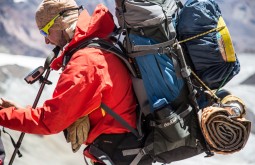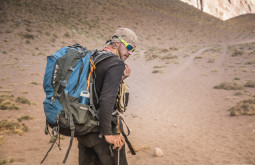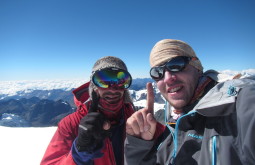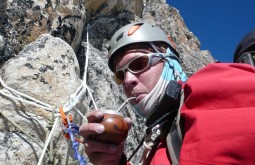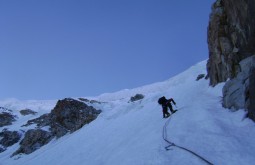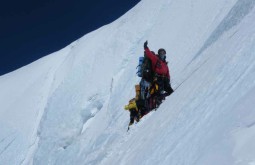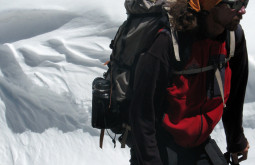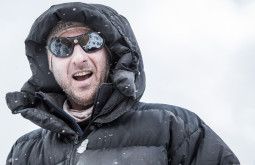Ojos del Salado - 14 days
About
Ojos del Salado - February 2023- 12 Feb 2025 until 25 Feb 2025
- 28 Feb 2025 until 13 March 2025
Ojos del Salado (6898m) is the world’s largest volcano and Andes’ second highest peak. Is at Chile/Argentina border but we normally climb it via Chile, although it can be climbed from Argentina as well. Ojos del salado is only 64 meters shorter than Aconcagua!
This is a fantastic opportunity to test your body at extreme altitudes in a straightforward itinerary. During the expedition, we will approach the mountains using 4WD vehicles up to the 5800 meters! Our Ojos del Salado trip uses a flawless acclimatisation plan designed by Maximo Kausch, our expert leader who has climbed 89 x 6000 metre Andean peaks and knows the region very well. The plan to climb Ojos is to tackle 3 mountains during the same expedition. We’ll work our way up Cerro Siete Hermanos (4780m), Mulas Muertas (5200m), Nevado San Francisco (6023m) and then Ojos del Salado (6898m).
Requirements to join this expedition are:
- International Travel Insurance;
- Altitude mountain climbing or multi-day altitude treks;
- Be healthy and fit enough;
- Fill the booking and medical form;
- Read all the information available on this website.
More information:
- Check out the weather at Ojos del Salado: http://www.mountain-forecast.com/peaks/Nevados-Ojos-del-Salado/forecasts/6880
Related News
- AltaMontanha: An example of how to eliminate a huge problem
- 5 x 6000 metre peaks in 12 days: 5 x 6000 metre peaks in 12 days
- AltaMontanha.com: 7 expeditions and 7 summits: Maximo’s success as expedition leader
Itinerary
Ojos del Salado - 14 daysDay 1 – Arrival to Copiapo – 800m
We’ll pick you up at the airport, 50km away from Copiapo. In the same day, we will check your personal equipment, making all final adjustments and shopping if necessary. Today we’ll have our first dinner together and meet the rest of the team. Included: transport and hotel
Day 2 – Copiapo – Laguna Santa Rosa Hut – 3700m
After a 210km drive, we’ll sleep in a small mountain hut at the edge of a beautiful salty lagoon called Santa Rosa. Included: Breakfast, transport, lunch, and dinner
Day 3 – Acclimatization on Siete Hermanos – 4780m
We’ll climb Siete Hermanos up to its summit or go as high as we can depending on the team’s condition. This is a fairly ‘low’ 4780m peak near Laguna Santa Rosa. Included: Breakfast, lunch, and dinner
Day 4 – Laguna Santa Rosa Hut – Laguna Verde Hut – 4300m
After a nice and generous breakfast, we’ll drive 120km to Laguna Verde. We’ll cook and gather in a small mountain hut and sleep in tents. The good news is that inside the hut there is a rather large pool of warm water which comes from nearby hot springs. Included: Breakfast, lunch, dinner (and bath!)
Day 5 – Climb to Mulas Muertas – 5200m
Another day of acclimatisation. Today is our turn climb Mulas Muertas located just a few kilometers away from our hut. Again, we’ll take it very easy and go as high as we can without compromising our bodies. Included: Breakfast, lunch, dinner (and bath again!)
Day 6 – Rest day – 4300m
Today we’ll rest on Laguna Verde.
Day 7 – Climbing Nevado San Francisco – 6023m
After a very early breakfast, we’ll put our plastic boots and packs on and then drive to 5000 metres to start the climb to Nevado San Francisco via the north ridge. The drive takes about 30 minutes and the climb might take us 5 to 7 hours. Would be great if you can try you best to get to the top as this will really push your confidence and acclimatisation. After summiting, our 4WD vehicles will be waiting for us at the bottom, then take us back to the hut. Included: Breakfast, packed lunch, transport, and dinner
Day 8 – Rest day – 4400m
Today will rest at Laguna Verde and recover from yesterday’s climb. Included: Breakfast, lunch, and dinner
Day 9 – Drive to Atacama Hut – 5200m
A 2-hour drive to a higher hut named Atacama. Only this time its a 5200 metre high hut and the roads can be quite bad. Today you get to relax (or try to) and enjoy the lunar landscape to Atacama Hut while our skillful drivers do what they do best. Included: Breakfast, lunch, dinner and offroad insane transport
Day 10 – Atacama Hut – Tejos Hut – 5800m
This is when we finally put large backpacks on and stop driving! After an early lunch, we’ll walk for 3 to 5 hours to a 5800 metre metal hut named Tejos. Included: Breakfast and lunch
Day 11 – First summit attempt – 6898m
After a 3am start, we expect a 7 to 9-hour push to the summit. The climb starts with straightforward switchbacks then changes to a huge traverse at 6500m. We then reach the main crater and work our way to the summit over a final steep gully and a technical 10-metre rock section to the main summit. Included: chance of summiting the largest volcano on Earth!
Day 12 – Second summit attempt
In case weather was bad yesterday
Day 13 – Drive back to Copiapo
Included: transport and hotel
Day 14 – Flight out
** The above itinerary is subject to change due weather conditions, performance of the group, political/administrative problems and any other events not described.
Equipment
Having good mountaineering equipment is one of the key points to have a successful expedition. Please note all your personal equipment will be checked by one of our guides in the hotel. You can rent equipment in Copiapo, please let us know in advance what do you need so we let you know availability and prices.
Head
-
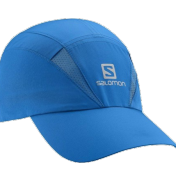
Hat or cap
For sun protection
-

Bandana
Buff or similar
Quantity: 1 or 2 -

Balaclava
To protect your face on summit push
Quantity: 1 -

Hat
Woollen hat or similar for cold days
Quantity: 1 -

Ski goggles
UV protection goggles to be used during storms or very cold conditions
Quantity: 1 (rental for U$30) -

Sunglasses (cat 3 or 4)
With side protection to fit your face
Quantity: 1 (rental for U$30) -

Sunscreen and lip balm
30 FPS or more
Quantity: 1 -

Batteries
AA or AAA batteries depending on your headtorch. Can be purchased in local store.
Quantity: 1 set -

Headtorch
Working headtorch and spare batteries
Quantity: 1
Torso
-

Light down jacket
Quantity: OPTIONAL
-

Summit Down Jacket
Heavy hooded down jacket for cold conditions
Quantity: 1 (rental for U$97) -
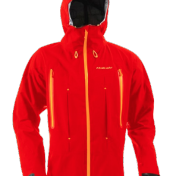
Snowproof jacket
A good snow, rain and windproof jacket
Quantity: 1 (rental for U$67) -

T-shirt
Synthetic fibre long or short sleeve t-shirt
Quantity: 4 or more -

Fleece jacket
Used alone or as part of a layer system for better performance
Quantity: 1 (rental for U$30)
Legs
-
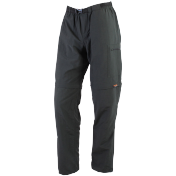
Trekking pants
Light trekking pants
Quantity: 2 or 3 -

Gaiters
For snow, sand or scree terrain
Quantity: 1 pair (U$24 for rental) -
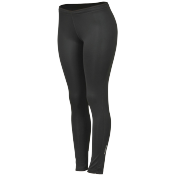
Base layer pants
For very cold days and summit push
Quantity: 1 -

Snowproof pants
Goretex or similar pants will be used for high wind or during snow conditions
Quantity: 1 (rental for U$55) -

Fleece Pants
Fleece, polartec or similar. To be used with other layers for very cold conditions
Quantity: 1 (rental for U$30)
Hands
-

Hand warmers
Chemical hand warmers for the summit push.
Quantity: 1 or 2 -

Mittens
Thick down mittens for summit push
Quantity: 1 pair (rental for U$42) -

Gloves
Fleece or polartec gloves for every day use
Quantity: 1 pair (rental for U$15)
Feet
-

Sandals or crocs
Sandals or crocs for river crossing or hanging around camp
Quantity: OPTIONAL -

Trekking boots
Waterproof trekking boots, try wearing them before the expedition
Quantity: 1 pair (rental for U$55) -

Trekking socks
Good thick trekking socks
Quantity: 4 or 5 pairs -

Thick expedition socks
For summit day
Quantity: 1 pair -
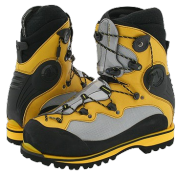
Double boots
A pair of double or double plastic boots such as Koflach Exped, Koflach Vertical, Asolo Ottomilla, Asolo AFS, Trezetta, Scarpa Vega, Scarpa Inferno, La Sportiva Baruntse, Olympus Mons, La Sportiva Spantik, Scarpa Phantom, La Sportiva G2.
Single layer boots such as La Sportiva Nepal XT, EVO, Batura or Boreal Latok, ARE NOT SUITABLE.
Quantity: 1 (rental for U$115)
Technical equipment
-

Helmet
A light helmet with enough room for your clothing
Quantity: 1 -

Harness
A good light alpine harness
Quantity: 1 -

Crampons
Crampons with antibott system
Quantity: 1 pair (rental for U$49)
Other Equipment
-

Carbo gels
These gels help out on recovery
Quantity: 3 -

Snacks
Salty snacks, sweets, etc. Any sort of tasty ready food as complement. On high altitude mountains we don’t normally worry about vitamins and proteins as these kinds of food are too hard to digest. You can buy all these in a local market.
Quantity: 2kg -

Stuff sacks or bin bags
Helps to keep your stuff dry and organised
Quantity: 2 or 3 -

Sleeping Bag
A good down sleeping
Quantity: -10C (Comfort temperature) - rental costs U$79 -

Rucksack
A decent rucksack with hip belt and rain cover
Quantity: 55 litres or more (rental for U$55) -

Altitude medicine
Our guides already have pretty much any drugs you might need during any trip. However, it would be great if you could have a spare tab of the most used drugs:
Ibuprofen (Advil)– This is an anti-inflammatory and works great for high altitude head aches
Quantity: kit
Loperamide (Imodium) – controls diarrea (not to be used in case of digestive infections. Ask our guides) -

Personal Hygiene kit
Soap, tooth brus, come, etc
Quantity: 1 -

Sleeping mattress
We prefer taking 2 foam sleeping mattress because of sharp rocks. If you have an inflatable mattress you should also bring a foam mattress to protect the inflatable one against sharp rocks. Don’t forget bringing a repair kit if you have an inflatable mattress.
Quantity: 2 (rental for U$24) -

1 litre thermos
Metallic good quality 1 litre thermos for the summit push. You must have one. Please do not bring smaller ones.
Quantity: 1 -

Water bottle
Nalgene 1 litre bottles or similar are great for expeditions! We prefer to not use camelbacks as its hose pipe might freeze
Quantity: 2 x 1 litre or 3 x 600ml -

Duffel Bag
Used to transport or store your equipment. In many cases, we transport your personal gear on animals and we don’t want your equipment to get wet or have mule smell…
Quantity: 1 - Rental for U$30 -
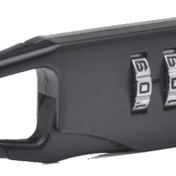
Padlock
To lock your duffel during transportation
Quantity: 1 -

Trekking poles
Gives you more stability during walk and summit push.
Quantity: 1 or pair (U$ 30 for rental)
FAQ
Where should I fly to?
The best way to get to Copiapo is to fly to Santiago (usually via LAN Chile) then take a secondary flight (usually via Sky Airlines) to Copiapo. The second flight can be very cheap. Also, search for flights from your home country to Copiapo. LAN does the connection and it might be cheaper sometimes.
What are the huts like?
The huts are abandoned and maintained by commercial expeditions and mountaineers who frequently climb any of the 38 x 6000m peaks in the surrounding area. Laguna Santa Rosa Hut is usually well maintained as more people visit more frequently. Also, there is a CONAF station (park rangers) 100 metres away from it. 9 people can sleep in mattresses comfortably inside.
Laguna Verde Hut is very basic. We normally don’t use its 6 mattresses inside and we only use it for cooking and go to the warm pool inside.
Claudio Lucero is huge! It has 16 mattresses and 2 floors. It doesn’t have any regular maintenance but is usually fairly clean.
Atacama Hut has 4 mattresses and is basically a wooden container size hut with a small kitchen. We usually cook inside and camp outside. There are very good tent platforms there.
Tejos is the more ‘sophisticated’ one. It’s an L-shape conglomerate of 2 standard containers brought in by a mining company in the early 90’s. It has a kitchen, shelves, and beds. Fits 9 people sleeping comfortably on mattresses.
If there are more teams climbing Ojos, we usually use the ‘first to arrive first to use’ but we are generous specially when other teams don’t have tents or someone is sick.
Can I rent equipment in Copiapo?
Yes, you can rent all equipment in Copiapo. You need to let us know earlier though. Let us know and find out the current prices for renting equipment for the whole length of the climb.
Do you think I’m able to climb 4 summits in just 13 days?
Keep in mind that the Siete Hermanos, Mulas Muertas and Vicuñas are just acclimatisation mountains and not our expedition’s goal. In our last expedition to the vast majority of our clients did summit Vicuñas (6067m) but for safety reasons, we didn’t go all the way on Siete Hermanos and Mulas Muertas.
Can I hire a porter at Ojos del Salado?
Unfortunately, it is a very remote mountain and there are no permanently installed services there.
Is there electricity in the huts?
The mountain huts we’ll use are very basic. Most of them were abandoned over 20 years ago and the only maintenance is done by mountaineers. There are no power plugs or any kind of services in these huts. There are however mattresses and some furniture that make our stay easier.
I can exchange money in Copiapo?
Yes. There are exchange offices that buy US dollars, sterling and euro in Copiapo. Best rates are in US dollars.
How much equipment will I have to carry? Can I can make it?
Your backpack will never weigh more than 12-15kg. The only time you will have to carry your personal gear is from the Atacama hut to Tejos, at 5800m.
The entire group of equipment will be purchased, assembled, clean and carried by guides and porters. You will NOT have to carry these (unless you are very nice and want to help). On the way to the last camp, you’ll be carrying your sleeping bag, crampons, clothing and some smaller items.
There is communication on the mountain?
Yes! At any time you can use our satellite phone. The calls cost USD 3/minute. Throughout the expedition, we will post daily updates to our Facebook page via SPOT satellite.
Would you guys call my family and tell them I’m alright?
Of course! Even better! We have a blog that is updated every day! We normally post messages or photos about the expedition progress. Please visit our Facebook page and check the latest posts.
I’ve heard Ojos is just a walk, is it true?
In fact, Ojos is not a technical mountain. Only the last 10-15 meters are technical but we normally have a fixed line to help you out on that last bit. Don’t forget the mountain is almost 7000 meters high. Altitude and bad weather have caused many people to lose their lives because they didn’t respect their own boundaries and underestimated the mountain.
Can I charge my iPhone battery or my camera?
Yes! We have solar panels to charge batteries, iPods, etc. Of course this changes when there’s not enough sunlight. Car 12V DC plugs are also an options while our vehicles are on the move.
What if I abandon or quit the expedition?
If you quit the expedition 1 week before departure, it is possible to recover part of your investment. Contact us and find out more.
If you quit the expedition in Copiapo, you can continue enjoying the services we provide you such as transportation and hotel. However we can not pay back the money you invested because logistics will already be hired.
If you quit the expedition after we left Copiapo, you will have to cover individual transportation and accommodation costs. Everyone who leaves the expedition for personal or health reasons should pay these costs.
If you give up during the summit attempt, you will never have to go down alone. Usually, we coordinate your descent with more expedition members. One of the guides will always be with you.
To leave Ojos del Salado, one of our vehicles will have to travel 600km to make a roundtrip to Copiapo. Fuel, maintenance and guide’s expenditure must be covered in case you wish to return home.
What’s your philosophy?
We accept women and men of any age, experience or ambition. We ask our members to be patient, respect the leader’s decisions and never go up or down alone.
Remember that you don’t pay us to take you to the summit, you pay mountaineering professionals with several years experience to help you up and down a steep mountain in the safest possible way.
Our itinerary may seem slower than other companies, this is due to a longer acclimatisation plan based on safety. More days will actually improve the chance of reaching the summit!
How much money should I take?
You should take enough money in case you decide to abandon the expedition. We recommend you to bring a total of USD 400 in US currency and 40.000 or more in Chilean pesos for the whole trip.
Can pay for rental equipment with a credit card?
No, this must be paid in US dollars to our guides.
How much does the climbing permit costs?
There is a required permission to climb Ojos del Salado called DIFROL. This has no cost and is carried by the expedition leader.
What sort of training do I need for big mountains like this one?
To 6000m mountains, we recommend you start training at least three months before, depending on your physical condition. Aerobic exercises like running and cycling are very useful. Ideally, ask a professional to recommend you a good aerobic training program. A very effective exercise is to go hiking with a rucksack on lower mountains. BEWARE of injuries! We have had some cases of clients who have trained too much and ended up hurting themselves.
What experience do I need for Ojos?
Ideally, anyone attempting Ojos should have climbed a 6000 metre peak before, in order to become familiarized with acclimatisation and snow walking. We, however, understand how hard it can be to have enough holidays in a year to climb these. So alternatively you can get away with just a multi-day altitude trek such as Everest Basecamp, Annapurna Basecamp or machu picchu.
How is the weather at Ojos del Salado?
This is a very windy mountain! It is also a very dry region where the wind from the Pacific starts at around 11am and blows until abut 5pm. It is common to have at least one snow storm during the expedition. Our team receives daily weather forecast updates.
What if I have a special diet?
Please tell us in advance about any food issues you might have and also please remind our guides about it too. Unless you bring your own food, we cannot help you if you are mmacrobiotic vegan or celiac due to extreme logistical difficulties. Contact us and let us know about your food restriction.
Who cooks at altitude camps?
We have very skilful guide/cooks! We guarantee you will e impressed about the meals!
Why do I have to bring freeze dried food?
We recommend our customers to bring 2 or 3 packs of freeze dried meals to camp 3. We have tried to serve a standard menu at camp 3 for several years but it never worked. One of the symptoms high altitude produces on the human body is the lack of appetite. Therefore people become very ‘picky’ on extreme altitudes so we prefer everyone brings their own meal.
Is there water at Ojos del Salado?
There is no liquid water in Ojos del Salado. Eventually some snow might melt and start running a little stream. These are however temporary and we cannot count on it. We take all the water from Copiapo. In our last expedition we took 320 litres of water for each whole expedition.
What if I have a health problem?
Our leader Maximo Kausch has extensive experience in mountain medicine and can solve most of problems you might encounter.
What if I need a rescue?
All our guides are trained rescuers and experienced in rescues on big mountains. Rescues can be made with one of our 4WD vehicles, this way you can get to a hospital in just three hours.
Do you recommend the use of Diamox?
NOT for the Central Andes. In extreme altitudes like the Himalayas or Karakorum we do recommend using Acetilzolamide or Diamox. This drug seems to actually work during the acclimatisation period by increasing the breathing rate at night (reduces CO2 levels), and also is a diuretic which eliminates sodium out of your system. In the Andes mountains however, mountains are too dry and taking diuretics such as Diamox actually decrease your acclimatisation capacity.
I was climbing in Peru before and I had a hard time communicating to my guide. Do your guides speak any english?
Yes, our leader Maximo Kausch has lived in the UK for 10 years and speaks fluent english. Please check our team’s information and find out about our guides’ communication skills.
What percentage of your clients actually make it to the summit?
It depends upon weather, experiences, fitness and their nationality. But usually about 75% of our european and north american clients get to the top.
Where do we go to the toilet on the mountain?
Ojos del Salado is not a controlled mountain. However we take care of it! There are designated toilets near each hut. Anywhere where there aren’t designated toilets, we make our ‘business’ in bin bags and take them back to Copiapo.
What’s the temperature my sleeping bag should stand?
We recommend you to bring good down sleeping bags with comfort temperature of -15 up to -22. Please note there are 2 types of temperatures shown in most of sleeping bags. We’re focusing on the “comfort temperature”.

View our photos of Maximo Kausch:
Related links about Maximo Kausch:
- Guinness World Records: Most 6000-m Andes mountains climbed
- Rock and Ice: Kausch Breaks Record for 6000m Peaks Climbed in Andes
- Mount Everest Foundation: Nameless Peaks of the Andes – Suzie Imber and Maximo Kausch
- National Geographic: Mountain cartographer
- Explorers Web: Maximo Kausch going for all 6000ers in the Andes
- The BMC: BMC member’s quest to climb all Andean 6,000m peaks
- Climbing Porn: Maximo Kausch builds “sofa” bouldering route at home
- American Alpine Journal: Mt. Parofes and Other Volcano Ascents
- Adventure Blog: Argentinian Climber Attempting All 6000 Meter Peaks In South America
- Leicester University: Discovery-led learning: Academic follows passion for adventure with aid from supercomputer
- Leicester University: University of Leicester mountain climber scales new heights to advance science
- Leicester University: Lecturer treks the unknown mountains of South America
- 8a.nu: Maximo Kausch beats the world record of 6000 summits in Andes
- BBC: Mountaineer wants to complete climbing marathon of the 117 highest peaks of the Andes
- BBC: Images of a mountain marathon while attempting a world record
- 4sports.ua: МАКСИМО КАУЧ ОТКРЫВАЕТ НОВЫЙ ШЕСТИТЫСЯЧНИК В БОЛИВИИ И СТАНОВИТСЯ ПЕРВЫМ В МИРЕ КТО ПОКОРИЛ 59 ШЕСТИТЫСЯЧНИКОВ
- Revista Vertical: ANDES 6000+ The unfinished list
- Reforma: The king of the 6000ers
- TARINGA!: A mountain marathon at the highest peaks of the Andes
- Desnivel: Maximo Kausch is halfway on his Andean project and ‘finds’ a new 6000er
Maximo Kausch
Founder and expedition leaderMaximo is sponsored by the following brands:
Language skills:
| English - native speaker |
| Spanish - native speaker |
| Portuguese - native speaker |
Maximo Kausch is one of the most accomplished climbers in the world. He is the current world record holder on number of 6000 metre peaks having reached the summit of 89 x 6000 metre peaks and climbed over 100 more extreme altitude worldwide. As expedition leader, Maximo has led several expeditions all over the world. He has climbed many 8000 metre peaks, including Mount K2 in Pakistan.
He was born in Argentina, raised in Brazil and lived over 10 years in the UK. Max is a full-time climber and guide. He literally spends most of his time in the mountains, mainly at the Andes and Himalaya. During his expeditions, Maximo has climbed some of the most remote mountains in the planet and visited at least 30 countries.
Max is a very calm person and focuses on safety and good acclimatisation plans during his expeditions. He is a trained rescuer and has extensive knowledge in high altitude medicine and medical emergencies. On his spare time, Maximo likes rock and mixed climbing in remote mountains.
In 2012 he started an unprecedented project alone and climbed 30 mountains over 6000 meters all alone. His project in now recognised as one of the main exploring projects in the Andes. Max wants to climb all 6000 metres peaks in the Andes by 2019, a total of 104. He has been to at least 11 x 8000-metre expedition at the Himalayas and has plenty extreme logistic experience. Over the years he has helped hundreds of clients to reach the summit of various mountains.
Awards
World Record: Maximo has recently become the record holder of the most number of 6000 metre peaks. He has been to at least 170 high altitude mountains over his 19 years of climbing experience.
More about Maximo Kausch
World Record on 6000 metre peaks

View our photos of Mario Sepulveda:
Mario Sepulveda
Expedition leader and rock climbing instructorLanguage skills:
| English - good command |
| Spanish - native speaker |
Chilean leader Mario Sepulveda Palma is our Atacama specialist. He is currently the person with the most ascents to Ojos del Salado - world’s largest volcano - with over 60 ascents. Mario is an excellent skier and competed in world championships as ski touring athlete. He also represented Chile in many competitions in other South American countries.
Mario started guiding in 2001. Since then he led expeditions in most of the Andes specially at the dry Atacama Andes. He has some pretty amazing accomplishments including an expedition to Kangchenjunga (8598m in Nepal) with no oxygen and no sherpas. Mario is certainly the guy you want to have around when you climb anything at the Atacama.
View our photos of Andy Jones:
Andy Jones
High Altitude Mountain GuideLanguage skills:
| Spanish - native speaker |
| English - excellent command |
Nearly everyone who went to Aconcagua has heard of Andy Jones. He's one of the most accomplished guides in the region and has summited Aconcagua 44 times! Andy was born in Rosario, Argentina's capital of the pampas (flatlands). During his early career, he worked as a physical educator (a job he's still very proud to keep), but eventually moved to Mendoza and lives there for the last 26 years. Andy Jones has climbed every sort of Andean mountain since he started climbing in the early 90s. He also climbed several high peaks including the highest in Peru, Bolivia, Chile, and Argentina. The well-known Andy Jones is an extremely relaxed and easy going person. All this patience probably led him to conquer the reputation of being one of the most successful guides in Argentina with one of the highest summit ratios in the country. Andy is definitely the guy who you want to have around if just started climbing high mountains.

View our photos of Eduardo Tonetti:
Related links about Eduardo Tonetti:
- From the office to the Andes: The story of the mountain guide Edu Tonetti: From the office to the Andes: The story of the mountain guide Edu Tonetti
Eduardo Tonetti
Mountain Guide and Trekking GuideLanguage skills:
| Portuguese - native speaker |
| Spanish - near native speaker |
| English - good command |
Eduardo Tonetti was born in São Paulo - Brazil and was in the advertising business for 15 years. In 2010 he decided to quit his career and guide for living. After 4 years of studies, Edu has graduated at EPGAMT Guiding School in Mendoza. He is now a professional mountain guide and a WFR trained rescuer, licensed to guide in Aconcagua among many other Andean peaks.
Edu has been a rock climber for 13 years and has extensive experience in several rock climbing areas. He specialized in high altitude mountaineering and climbed dozens of mountains in the region. Edu has climbed big mountains like Aconcagua (6962m, 11 times), Ojos del Salado (6898m), Tres Cruces Sur (6738m), Tres Cruces Central (6640m), Mercedario (6770M), Tupungato (6556m), Cerro Plata (5943m), Vicuñas (6087m), among others.
Eduardo has worked with human development and coaching in São Paulo, Brazil and he is now using mountaineering as coaching activities having amazing results!
He has been working in Aconcagua for the last 4 years in a row and started as a porter in 2012. He worked his way up and has now led several expeditions at Central and dry Andes.
Map
Cost
Price: USD 3100 per person
What’s included:
- Leadership of Andes Specialists, a network of highly skilled professional guides; experts in every region of the Andes.
- 1 or 2 assistant mountain guides (EPGAMT/AAGM certification) depending upon number or clients (client per guide ratio = 2/3);
- 20% off equipment rental at our partner store (we rent in Mendoza and take it to Copiapo);
- Transport from/to airport;
- 2 nights in a 3- star hotel in Copiapo – the rooms are shared by each two expedition members
- 4×4 transport from Copiapo
- Every night at the Laguna Santa Rosa refuges;
- Use of tents
- Use of medical kit
- Stoves and gas in all altitude camps
- All meals out of Copiapo
- Bureaucratic permissions (if necessary)
What is NOT included:
- Flights from/to Copiapo;
- Personal climbing equipment;
- Money return in case you abandon the expedition;
- International travel insurance;
- Lunch and dinner in Copiapo;
- Reimbursement for loss or damage of your personal equipment.
